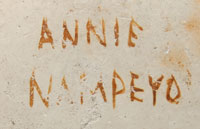Annie Healing Nampeyo - Quinchawa, Hopi-Tewa Potter
+ Add Artist to My Preferences
 Annie Healing Nampeyo or Quinchawa potted with her mother, Nampeyo of Hano, for many years and much of her work is indistinguishable from her mother's. According to Nampeyo biographer Barbara Kramer, Annie was Nampeyo's silent but visible partner in pottery making. However careful study has been able to differentiate several design styles between Annie and her mother. She preferred to paint black and white on red. Also her work was more delicate than her mother's. The first piece directly attributed to Annie was in 1912 by artist and anthropologist William Leigh. Annie continued to make pottery until the 1930s when arthritis forced her to quit.
Annie Healing Nampeyo or Quinchawa potted with her mother, Nampeyo of Hano, for many years and much of her work is indistinguishable from her mother's. According to Nampeyo biographer Barbara Kramer, Annie was Nampeyo's silent but visible partner in pottery making. However careful study has been able to differentiate several design styles between Annie and her mother. She preferred to paint black and white on red. Also her work was more delicate than her mother's. The first piece directly attributed to Annie was in 1912 by artist and anthropologist William Leigh. Annie continued to make pottery until the 1930s when arthritis forced her to quit.
Annie Healing (1884-1968) was Nampeyo of Hano's first child. She was given the unique name of Quinchawa. During this time Hopi trader Thomas Keam encouraged the Hopi to send their children to school. As Quinchawa came of school age before the day school at Polacca opened, she was sent to the boarding school in Keam's Canyon. Little Quinchawa returned after her first year at boarding school with the new name Annie. Annie didn't let her school experience change her belief in the traditional Hopi way. She continued to help her mother with pottery making during school breaks and when she finished her schooling returned to Hopi and worked with her mother full time making pottery.
Annie was married around the age of 16 to Willie Healing. His Hopi name was Ipwantiwa, but his name was changed at school to Willie. His last name was the English corruption of his mother's name Heli. Annie had six children, Rachel, Daisy, Dewey, Fletcher, Beatrice and Lucy. Rachel and Daisy both went on to become accomplished potters.
TAGS: Nampeyo of Hano, Hopi Pueblo, pottery making, Rachel, Daisy, Barbara Kramer, Thomas Keam

